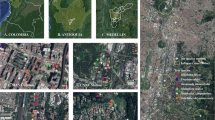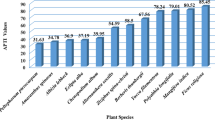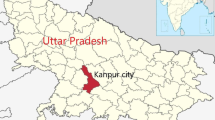Abstract
The effectiveness of tree species as bioindicators/biomonitors depends on appropriate selection based on their tolerance and sensitivity to air pollution, which is usually evaluated by the air pollution tolerance index (APTI). Despite the importance of the APTI in screening tree species for biomonitoring, there are still limitations to its usefulness in green belt establishment/management. Therefore, this study combined the APTI and anticipated performance index (API) to evaluate the potential of some tree species commonly growing on the campus of the University of Ilorin, north-central Nigeria, for green belt development. The study revealed that the APTI alone is not adequate for determining the suitability of tree species for green belt development, although it can be employed to identify sensitive plants for biomonitoring. The combination of the APTI and API in this study is a practical approach to developing a sink for air pollution control. The API indicated that Vitellaria paradoxa (API = 4) is a good performer in green belt development, while Terminalia catappa, Acacia nilotica and Prosopis africana (API = 3) are moderate performers. The present study suggests that integration of both the plant tolerance and performance indices for selection of tree species is very useful for the development of a green belt.
Similar content being viewed by others
Explore related subjects
Discover the latest articles, news and stories from top researchers in related subjects.Avoid common mistakes on your manuscript.
Introduction
Several studies have shown the impacts of air pollution on plant biochemical parameters, such as the ascorbic acid content (Hoque et al. 2007), chlorophyll content (Flowers et al. 2007), leaf extract pH (Klumpp et al. 2000) and relative water content (Rao 1977). The use of these different parameters has given conflicting results for the same species (Han et al. 1995); therefore, a single parameter may not provide a clear picture of the pollution-induced changes that may occur in plants. Furthermore, categorizing plants as being sensitive or tolerant by determining the levels of these parameters in plants may be ineffective since plants show different responses to different pollutants. It is on this premise that the air pollution tolerance index (APTI), based on the ascorbic acid content, chlorophyll content, leaf extract pH and relative water content of leaves of tree species, has been used for identifying the tolerance levels of plant species (Singh and Rao 1983; Liu and Ding 2008). The sensitivity and response of plants to air pollutants vary, and plant species that are more sensitive act as bioindicators of air pollution, while tolerant species according to the APTI are used for green belt development (Agbaire and Esiefarienrhe 2009).
The APTI index is effective in evaluating the effect of pollutants only on biochemical parameters, but in order to combat air pollution using green belt development, some socioeconomic and biological characteristics are considered to develop the anticipated performance index (API) (Govindaraju et al. 2012). The API is an improvement over the APTI, which has been used as an indicator to assess the capability of predominant species in the clean-up of atmospheric pollutants.
This study evaluates the results related to the APTI biochemical parameters in Terminalia catappa, Vitellaria paradoxa, Acacia nilotica and Prosopis africana from the University of Ilorin campus, north-central Nigeria. The results were combined with some relevant biological and socioeconomic characteristics (such as plant height, canopy structure, plant size, texture, hardness and economic value) to determine the API value to determine the suitability of the tree species for green belt development. Hence, the objective of the study was to evaluate/assess the suitability of the combination of the APTI and API for tree species selection for air pollution monitoring and green belt management.
Materials and methods
Study area
The study area was the perimeter of the main campus of the University of Ilorin, Ilorin, north-central Nigeria (18°20′N, 65°49′E) (Fig. 1). The study locations were classified into two zones: (a) the experimental [(1) the academic area, (2) the student residence area and (3) the staff residence area] and (b) control (nearby village). The location characteristics are presented in Table 1.
Sample collection
Four tree species (T. catappa, V. paradoxa, A. nilotica and P. africana), predominantly common to the four zones, were used for the study. Matured fresh leaf samples were collected in the morning from the tree species in all four study locations at different tree stand points. A tree stand was used as an experimental stand if the tree girth size was greater than 10 cm2, which indicated that the stand had become fully matured and had been growing for not less than 5 years. Fresh leaf samples (about 1 kg each) were collected from five different tree stands of each studied species and were immediately transferred to the laboratory for determination of the relative water content (RWC). The remaining samples were preserved in the refrigerator for further analysis.
Chemical analysis
Relative water content (% RWC) of the leaf was determined using the method of Liu and Ding (2008) as follows:
where FW is the fresh weight, DW is the dry weight of turgid leaves after oven-drying at 115 °C for 2 h, and TW is the turgid weight after immersion in water overnight.
Total chlorophyll content was determined using the spectrophotometric method (Arnon 1949; Chouhan et al. 2012), and leaf extract pH was determined using a glass electrode pH meter (PHS-3C model) by homogenizing 2.5 g of the fresh leaf sample in 10 ml distilled water; the pH was determined after pH calibration with a buffer at 4 and 9. Ascorbic acid (AA) content of leaves was determined using the spectrophotometric method (Begum and Harikrishna 2010). Four milliliters of oxalic acid-EDTA, 1 ml of orthophosphoric acid, 1 ml of 5 % tetraoxosulphate (VI) acid, 2 ml of ammonium molybdate and 3 ml of water were used as extractants for 1 g of the fresh leaves in a test tube. The solution was allowed to stand for 15 min and the absorbance read at 760 nm. The concentration of ascorbic acid in the sample was then extrapolated from a standard ascorbic acid curve.
The APTI proposed by Singh and Rao (1983) was determined by the formula:
where A is the ascorbic acid content (mg/g), T is the total chlorophyll (mg/g), P is the pH of the leaf extract, and R is the relative water content of leaf (%).
APTI | Value | Response |
|---|---|---|
A | <11 | Sensitive |
B | 12–16 | Intermediate |
C | 17 | Tolerant (Padmavathi et al. 2013) |
Statistical analysis and anticipated performance index (API) assessment
ANOVA and post hoc analyses (DMRT) were employed for the statistical analysis of the biochemical parameters using SPSS software (version 16.0). The resultant APTI values with the relevant biological and socioeconomic characters were combined, and the API was calculated for different tree species based on the character grading (+ or −) allotted to the plant. The criteria for determining the API for the studied tree species are given in Tables 2 and 3. Based on this grading system, a tree species can only secure a maximum of 16 positive points, and allotted points were scaled to a percentage system to produce categories of assessment (Prajapati and Tripathi 2008; Govindaraju et al. 2012).
Results and discussion
Effects of environmental air pollution on the biochemical parameters of leaves of the studied tree species
The impacts of environmental air pollution on the biochemical parameters of the studied tree species within the university campus are given in Fig. 2. The effects of ambient air pollution on the pH of leaf extracts of the tree species are shown in Fig. 2a. Changes in pH were pronounced and significant (P < 0.05) in A nilotica, P. africana and T. catappa because of the influence of ambient air pollution on the following sequence: academic area > student residence > staff residence. V. paradoxa also showed a significant change (P < 0.05) in the pH of the leaf extracts between the control and exposed locations, but no significant difference was observed across the exposed locations (Fig. 2a). The pH of the leaf extract ranged between 5 and 7; high pH is known to improve tolerance to air pollution (Agarwal 1986; Yan-ju and Hui 2008).
The total chlorophyll (T. Chl.) content differed significantly across the locations for all of the tree species. The highest T. Chl. contents for A. nilotica, P. africana and V. paradoxa were recorded at the staff residence, while T. paradoxa gave the highest T. Chl. at the academic area (Fig. 2b.). The control site had the least T. Chl. for A. nilotica, P. Africana and T. catappa. The high chlorophyll content recorded at the staff residence showed that A nilotica, P. africana and V. paradoxa exhibit tolerance to pollution in the area as a higher chlorophyll content might favor tolerance to pollutants (Joshi et al. 1993).
AA contents in all the tree species differed significantly (P < 0.05) from the control, but there were variations in the contents across the exposed locations for each tree species (Fig. 2). All the tree species in locations at the university had higher AA contents than the control at P < 0.05 (Fig. 2c). These findings are consistent with those of some other studies (Bermadinger et al. 1990; Kousar et al. 2014) in which the AA contents of tree species increased because of air pollution. AA is a natural detoxicant that prevents the damaging effect of air pollutants in plant tissues (Singh et al. 1991). Large amounts of ascorbic acid favor defense properties and pollution tolerance in plants (Lee et al. 1984; Cheng et al. 2007) and indicate high pollution levels. ssst is also important to note that the air pollution level in the academic area was high according to the resultant elevated AA contents of tree species in this location, which is consistent with the reported 0.35 mg/g and 2.39 mg/g for Eugenia jambolana and Psidium guajava from industrial areas in India (Kousar et al. 2014).
The RWCs of leaves of the studied tree species in the four locations are presented in Fig. 2d. RWC varied significantly across the locations in all the studied tree species (P < 0.05). The lowest RWCs were recorded in all the tree species growing in the staff residence area, while the highest RWCs were recorded in the tree species growing in the student residence area (Fig. 2d). High water content in plants ensures the maintenance of the physiological balance under stresses such as air pollution, and the RWC is usually associated with the protoplasmic permeability of cells, which is involved in the loss of water and dissolved nutrients in plants, resulting in senescence of leaves (Agarwal and Tiwari 1997; Tsega and Devi-Prasad 2014).
Assessment of the APTI and API of the tree species for environmental health
Table 4 shows the APTI values for the four tree species within the university community. The APTI values for the four tree species were highest in the student residence area, and the mean APTI indicated T. catappa has the highest tolerance (12.30) to air pollution among the tree species. The least was recorded for V. paradoxa (7.80) (Table 4). The low APTI value (<15.0) recorded for the four tree species is indicative of the moderate level of air pollutants within the university campus. A previous study by Dwevidi and Tripathi (2007) put the APTI value of trees in severely polluted environments at 81.10. The low APTI value (7.80, 9.56 and 10.95, respectively) for V. paradoxa, P. africana and A. nilotica indicated that these plants are sensitive to air pollution and can be recommended as bioindicators. Sensitive species have been reported to be ideal bioindicators (Kousar et al. 2014), and tree species with high APTI values are tolerant to pollution (Tsega and Devi-Prasad 2014) and can be used as sinks.
Table 5 presents the evaluation and grading of tree species based on their APTI and relevant socioeconomic and biological parameters. V. paradoxa showed the higher grade (62.50 %), while the other three tree species resulted in 52.65 % each (Table 5). Results of the API in Table 6 indicate V. paradoxa can be anticipated to be a good performer, while T. catappa, P. africana and A. nilotica are predicted to be moderate green belt performers. The API assessment of the tree species showed that V. paradoxa could be an ideal species for green belts, especially in urban areas, to alleviate pollution and make significant contributions to the ecosystem. Tsega and Devi-Prasad (2014) reported that tree species with high API values are recommended for establishing green belts. V. paradoxa has a dense canopy of evergreen foliage and is well known for its economic value. T. catappa, P. africana and A. nilotica are anticipated to be moderate performers and can be recommended for plantation because of their economic value and also their ability to serve as a sink.
Conclusion
This study showed that the assessment of only the APTI value for tree species may not be ideal for recommending trees for ecological purposes, but the combination of the APTI and API can be of immense importance. It is evident from this study that the single criterion of the biochemical parameters played a distinctive role in determining the response of tree species to air pollution but may not be ideal for evaluation of plant responses to a variety of pollutants for green belt purposes. However, using the combination of the biochemical parameters (APTI), biological and socioeconomic characteristics has proved feasible for recommending tree species for ecological purposes.
References
Agarwal SK (1986) A new distributional function of foliar phenol concentration in the evaluation of plants for their air pollution tolerance index. Acta Ecol 8(2):29–36
Agarwal SK, Tiwari SL (1997) Susceptibility level of few plants on the basis of air pollution tolerance index. Indian For 123:319–322
Agbaire PO, Esiefarienrhe E (2009) Air pollution tolerance indices (APTI) of some plants around Otorogun gas plant in Delta state, Nigeria. J Appl Sci Environ Manag 13:11–14
Arnon DI (1949) Copper enzymes in isolated chloroplasts polyphenol oxidase in Beta vulgaris. Plant Physiol 2(1):1–15
Begum A, Harikrishna S (2010) Evaluation of some tree species to absorb air pollutants in three industrial locations of South Bengaluru, India. E-J Chem 7:151–156
Bermadinger E, Guttenberger H, Grill D (1990) Physiology of young Norway spruce. Environ Pollut 68(3–4):319–330
Cheng FY, Burkey KO, Robinson JM, Booker FL (2007) Leaf extracellular ascorbate in relation to ozone tolerance of two soya bean cultivars. Environ Pollut 150:355–362
Chouhan A, Iqbal S, Maheshwari RS et al (2012) A study of air pollution tolerance index of plants growing in Pithampur industrial area sector 1, 2 and 3. Res J Recent Sci 1:172–177
Dwevidi AK, Tripathi BD (2007) Pollution tolerance and distribution pattern of plants in surrounding area of coal-fired industries. J Environ Biol 28(2):257–263
Flowers MD, Fiscus EL, Burkey KO (2007) Photosynthesis, chlorophyll fluorescence and yield of snap bean (Phaseolus vulgaris L.) genotype differing in sensitivity to Ozone. Environ Exp Bot 61:190–198
Govindaraju M, Ganeshkumar RS, Muthukumaran VR, Visvanathan P (2012) Identification and evaluation of air-pollution tolerant plants around lignite-based thermal power station for greenbelt development. Environ Sci Pollut Res 19(4):1210–1223
Han Y, Wang QY, Han GX (1995) The analysis about SOD activities in leaves of plants and resistance classification of them. J Liaoning Univ 22:71
Hoque MA, Banu MN, Okum E (2007) Exogenous proline and glycinebetaine increase NaCl-induced ascorbate-glutathione cycle enzyme activities, and proline improves salt tolerance more than glycinebetaine in tobacco bright yellow-2 suspension-cultured cells. J Plant Physiol 164:1457–1468
Joshi OP, Pawar K, Wagela DK (1993) Air quality monitoring of Indore city with special reference to SO2 and tree barks pH. J Plant Physiol 148:249–257
Klumpp G, Furlan CM, Domingos M, Klumpp A (2000) Response of stress indicators and growth parameters of Tibouchina pulchra Cogn. exposed to air and soil pollution near the industrial complex of Cubatao, Brazil. Sci Total Environ 246:79–91
Kousar H, Nuthan KD, Pavithra K, Adamsab MP (2014) Analysis of biochemical parameters as tolerance index of some chosen plant species of Bhadravathi town. Int J Environ Sci 3(1):11–16
Lee EH, Jersey JA, Gifford C, Bennett J (1984) Differential ozone tolerance in soybean and snap beans: analysis of ascorbic acid in O3 susceptible and O3 resistant cultivars by high performance liquid chromatography. Environ Exp Bot 24:331–341
Liu YJ, Ding H (2008) Variation in air pollution tolerance index of plants near a steel factory: implication for landscape-plant species selection for industrial areas. WSEAS Trans Environ Dev 4:24–32
Padmavathi P, Cherukuri J, Reddy MA (2013) Impact of air pollution on crops in the vicinity of a power plant: a case study. Int J Eng Res Technol 2(12):3641–3651
Prajapati SK, Tripathi BD (2008) Anticipated performance index of some tree species considered for green belt development in and around an urban area: a case study of Varaasi city, India. J Environ Manage 88:1343–1349
Rao DN (1977) Use of plants as indicators and monitors of SO2 pollution. Chem Age Indica 28:665–672
Singh SK, Rao DN (1983) Evaluation of plants for their tolerance to air pollution. In: Proceedings symposium on air pollution control of indian association for air pollution control in New Delhi, India, pp. 218–224
Singh SK, Rao DN, Agrawal M, Pande J, Narayan D (1991) Air pollution tolerance index of plants. J Environ Manag 32:45–55
Tsega YC, Devi-Prasad AG (2014) Variation in air pollution tolerance index and anticipated performance index of roadside plants in Mysore, India. J Exp Biol 35:185–190
Yan-ju L, Hui D (2008) Variation in air pollution tolerance index of plant near a steel factory: implications for landscape-plant species selection for industrial areas. Environ Dev 1:24–30
Conflict of interest
The authors declare that there is no conflict of interest related to this study.
Author information
Authors and Affiliations
Corresponding author
Rights and permissions
About this article
Cite this article
Ogunkunle, C.O., Suleiman, L.B., Oyedeji, S. et al. Assessing the air pollution tolerance index and anticipated performance index of some tree species for biomonitoring environmental health. Agroforest Syst 89, 447–454 (2015). https://doi.org/10.1007/s10457-014-9781-7
Received:
Accepted:
Published:
Issue Date:
DOI: https://doi.org/10.1007/s10457-014-9781-7






